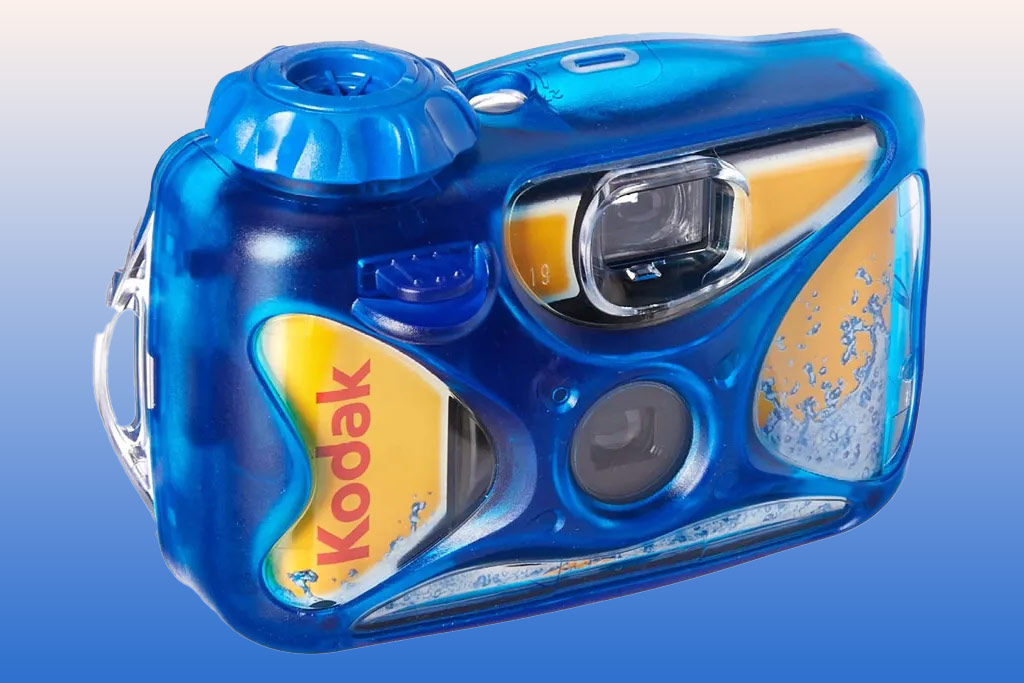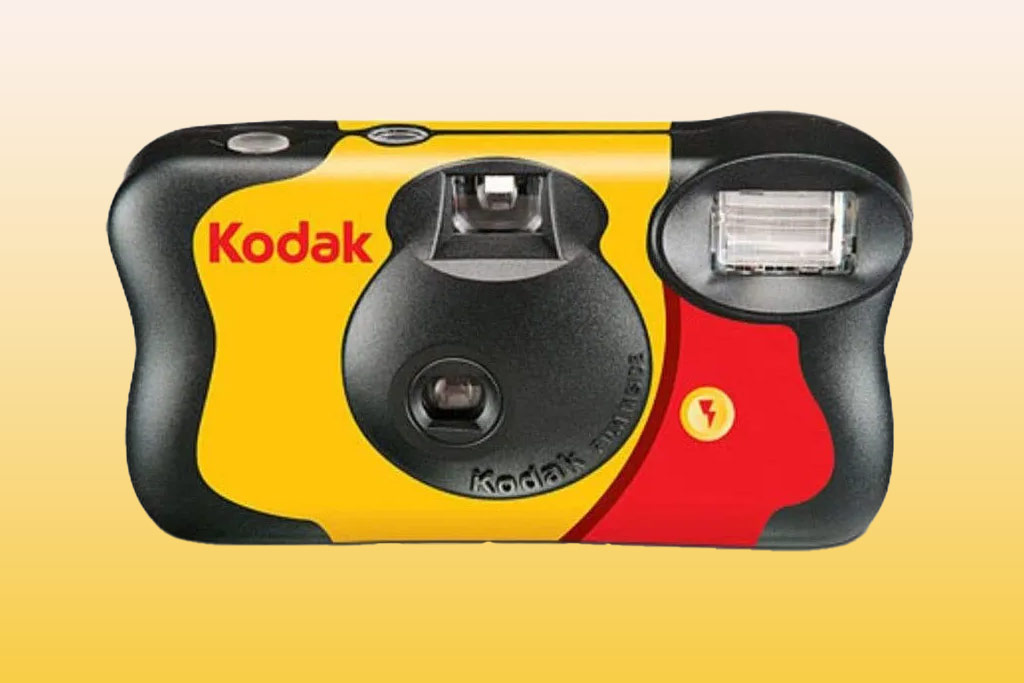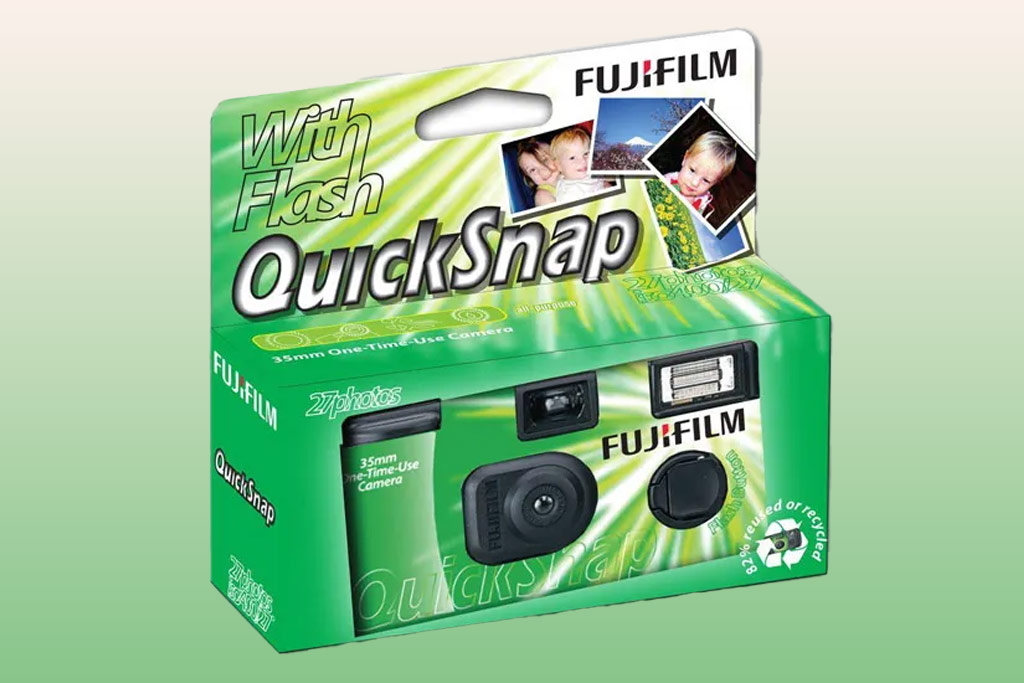The best disposable film and instant cameras are, it’s fair to say, having a moment. Thanks to virality on TikTok and beyond, more and more budding photographers of different ages are discovering the knockabout, retro, analogue joys of a good disposable camera. From the physicality of the prints themselves to the anticipation of waiting for your film to come back to see what you’ve captured, a good disposable camera feels in many ways like the antithesis to the ubiquitous nature of digital smartphone imagery.
And here’s some more good news – disposable cameras are often more environmentally sound than you may assume. Many can be sent for development directly back to their manufacturers, who will then reload the camera for re-use. Alternatively, there are options like Lomography’s ‘Simple Use’ cameras, which give you all the point-and-shoot simplicity of a disposable, but in a camera body that can be reloaded with new film.
Many of our writers at AP are huge fans of analogue photography, and we have published plenty of articles on how to get the most out of film, including our guide to how to do film photography on a budget, and how to get started with film photography.
For this guide, we’ve picked out the best disposable film cameras that we feel are worth your time, including options from Kodak, Ilford, Fujifilm and others.
The best disposable film camera: quick list
Looking for the best deal on disposable film cameras? Not only will you find the best disposable cameras, but you’ll also find some of the best disposable camera deals, as our ‘Buy now’ buttons are setup to automatically take you to the best prices, from trusted retailers, plus you’ll also find a list of other retailers below each camera, so you can find the right deal for you.
- Best for black and white: Ilford XP2 Single Use Camera – Buy now
- Best for image quality: Kodak Professional Tri-X 400 Single Use Camera – Buy now
- Best waterproof disposable camera: Kodak Sport Underwater Camera – Buy now
- Best for creativity: Lomography Simple Use Camera – Buy now
- Best for kids: Agfa Single Use 27 Exposure Camera – Buy now
- Best for weddings: Kodak FunSaver Single Use Camera – Buy now
- Best for flash: Fujifilm QuickSnap Flash – Buy now
- Best for travel: Ilford Ilfocolor Rapid Retro – Buy now
Why you can trust Amateur Photographer
We spend many hours testing every product we recommend, in detail, in a variety of situations and shooting scenarios, and only use experts for our reviews, so you can be sure that you’re getting the best products. Find out more about our expert writers.
While Kodak and Fujifilm spearheaded disposable film cameras, there are many more options for disposable 35mm film cameras now. Here’s a roundup of the best options…
Best for black and white
Best disposable for black and white: Ilford XP2 Single Use Camera
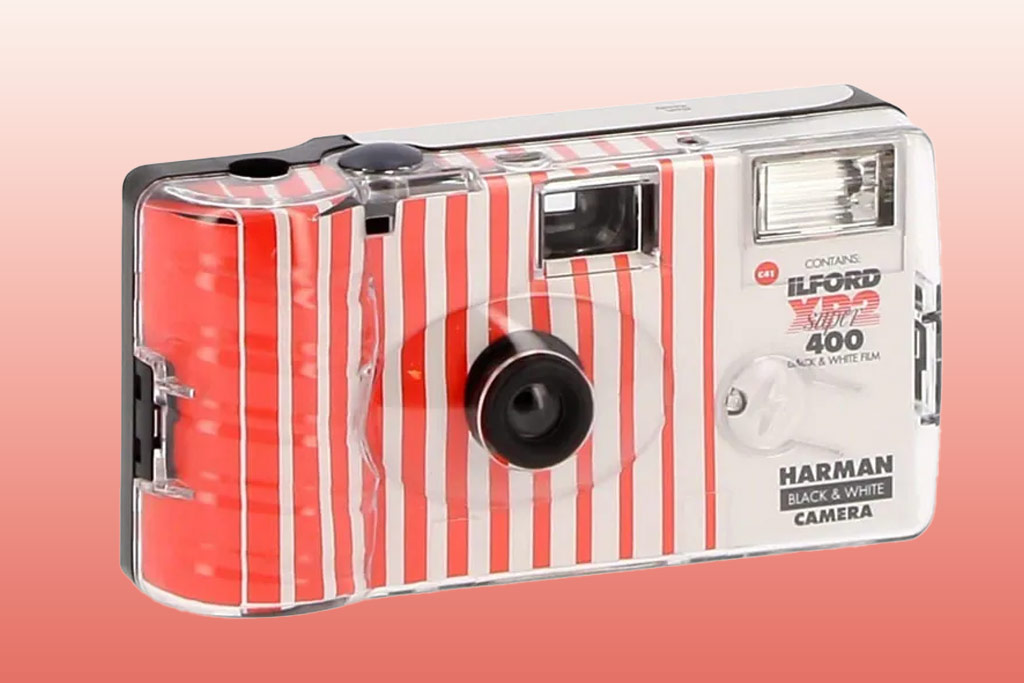
At a glance:
- Built-in flash
- ISO 400 film
- 27 exposures
- Compatible with C41 film processing
- Price: $30 / £22
For timeless black-and-white photography, this is the camera to go for. It has one major benefit over monochrome models: its film can be developed at most high-street C41 labs, which means it doesn’t require a specialist black-and-white one (which can be a bit more costly). You can get 27 shots from the camera, and there’s a built-in flash.
The camera offers 27 shots, features a toggle-able flash and, most importantly, produces artsy black-and-white images. It is best to avoid low light situations with this camera, though you can use the flash in these scenarios.
Best for image quality
Best disposable camera for quality: Kodak Professional Tri-X 400 Single Use Camera

At a glance:
- Built-in flash
- ISO 400 film
- 27 exposures
- High-contrast black and white film
- Price: $15 / £20
Loaded with high-contrast Kodak Tri-X 400 film, this is a black-and-white camera for those who like a little drama to their photography. With a good amount of grain and punchy tonality, it delivers memorable and interesting images, particularly on days with a lot of bright light and deep shadows. The quality of the 30mm optic on this camera is good too – not blow-you-away amazing, but definitely good enough to make the most of the film. Subjects tend to be sharpest at around 3 metres distance, so keep that in mind when composing.
Best waterproof disposable
Best underwater disposable camera: Kodak Sport Underwater Camera
At a glance:
- Waterproof up to 15 metres under water (50 feet)
- Durable, with a shock-proof shell
- Sunscreen and scratch resistant lens
- 27 exposures
- Colour film
- Price: $28 / £19
Ideal for shots by the beach, and at shallow depths in the pool, the waterproof Kodak Sport Underwater camera is a hard-wearing piece of kit. It has chunky control buttons and comes in a plastic case, making it ideal for use by kids. It’s best used in daylight and outdoors as there’s no flash. When shooting underwater, it performs well when the water is clear and bright. This model is not suitable for diving!
It can sometimes be hard to get your hands on this specific model as it often gets sold out, so a good alternative to bear in mind is the AgfaPhoto LeBox Ocean Disposable.
Best for creativity
Best disposable camera for creativity: Lomography Simple Use Film Camera
At a glance:
- Reloadable film
- 36 shots per film
- Built-in flash
- Optional colour gel filters
- Price: £36 / $25
It may sound contradictory, but this is a reusable disposable camera: you can keep refilling the film, which makes it a more budget- and eco-friendly option to other disposable cameras on the market, if you’re planning on shooting more than the generous 36 shots included in the pre-loaded film. This is practical and economical as a new roll of film usually costs less than buying a whole new camera, as long as you can find film.
The camera body comes with three coloured gels that you can slide over the flash to give the images different tints and add more creativity to your analogue photography. The shutter speed is quite fast – 1/120s – and so this camera can be used to capture fast-moving subjects.
Best for kids
Best disposable camera for kids: Agfa Single Use 27 Exposure Camera
At a glance:
- Cheap
- Easy to use
- Built-in flash
- 27 exposures
- Price: $15 / £14
A compact and budget-friendly disposable camera that is easy to use and best of all, features a flash. It’s good for everyday scenarios, both indoors and outdoors. Cheap, cheerful and easy to spot, it’s a good one for kids who might be taking their first steps into non-smartphone photography. The flash is built-in, and exposures are generally pretty spot-on, especially indoors, but this camera can be hard to find at times.
Best for weddings
Best disposable camera for weddings: Kodak FunSaver Camera
At a glance:
- Built-in flash
- 800 ISO film
- Colour film
- From 27 exposures
- Price: £22 / $18
A versatile and reliable camera, the Kodak FunSaver performs just as well in bright sunlight and low light thanks to its high ISO. It’s a cheap option that produces brilliant results, ideal for beginners to the world of disposable cameras.
It comes preloaded with Kodak Gold film inside, so the tone of your photos will be warm and flattering. This disposable camera is common at weddings because it is available in multipacks and also has a 27-shot version and 39-shot version – a good one to stock up on!
Best for flash
Best disposable camera for flash photography: Fujifilm QuickSnap Flash 400
At a glance:
- Built-in flash, with automatic flash recharge
- 400 ISO film
- 27 shots
- Price: $15 / £17
This camera has the most practical flash off the lot, because you don’t need to press the flash button for every shot but can just keep it on by toggling the continuous flash switch. This makes it ideal for quick-fire shots in low light scenes – you can focus on taking the photo without worrying about the light. Without flash, it works brilliantly in daylight.
Best for travel
Best disposable camera for travel: Ilford Ilfocolor Rapid Retro 27
At a glance:
- Built-in flash. Flash recharge time: 15 seconds
- 27 exposures
- ISO 400 film
- Price: $18 / £20
A retro-looking camera that’s lightweight, it works well indoors and outside and produces photographs in saturated tones. While Ilford is mostly known for its black-and-white film, this camera produces images in glorious poppy colour that feels as though it leapt straight out of the 1960s. It’s a fantastic choice for travel, producing memorable images with well-saturated tones, However as of late it’s been difficult to find.
Why should I buy a disposable film camera?
Disposable film cameras are affordable, pocket-sized and easy to take everywhere. If you’re going somewhere that you would prefer not to take your expensive smartphone or digital camera, like a music festival or beach vacation, they can be a great choice.
They’re also incredibly easy to use, meaning children can also have fun with them. They won’t run out of battery, and they’re designed to be able to produce a decently exposed image in most shooting situations.
Plus, there’s the fun factor! Disposable cameras only let you point and shoot, with no previews or deletes, meaning you can simply live (and shoot) in the moment.
The limited number of exposures forces you to be selective about what you photograph, and makes you wait for the decisive moment. How many shots do you think are in your gallery that you’ve never looked at since you captured them? How different would it look if you could only shoot a limited number?
One of the joys of analogue photography is the feeling of delayed gratification and surprise that comes from having to wait for your photos to be developed. Also, disposable cameras give you physical prints of your images, ones that you can hold, keep, and give away. It’s much more tactile than digital files – though if you want digital copies, most modern labs will scan your negatives for you and email you the files).
How to choose your disposable film camera
Disposable film cameras come with their own fixed shutter speed, aperture (mostly f9-11) and focus. Most have a similar design, but there are certain features to bear in mind when choosing which one is right for you:
Shutter speed – most disposable cameras come with a 1/100 shutter speed but there are a few that have a faster shutter speed – more like 1/120 – which are slightly better for for rapid-fire shots and better at capturing fast-moving scenes. Using the built-in flash can also help capture fast movement.
Shot count – most disposable film cameras can take between 24 and 27 shots (known as exposures) though there are some that can handle up to 39 shots. The latter costs a bit more to purchase, but is ideal if you want a few extra snaps, and the extra exposures won’t really affect the cost of processing, so it is sometimes better value for money to buy a disposable film camera with more shots.
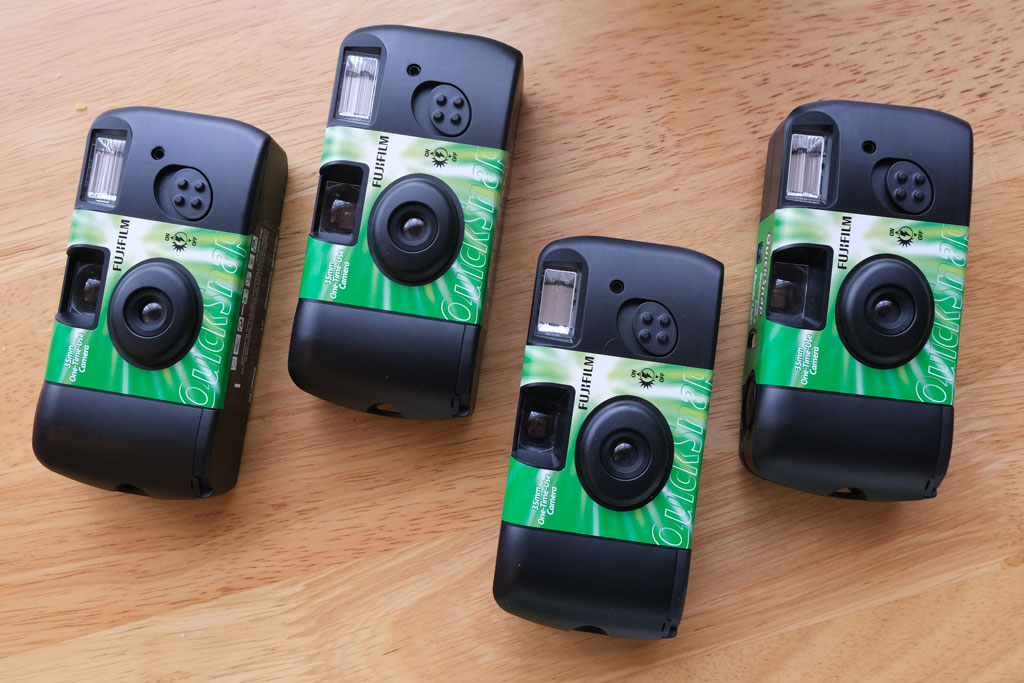
Flash – as you can’t change the shutter speed or aperture on a disposable film camera, you need to consider the amount of light when using it. If you’re planning to take photos in the evening or indoors, it’s advisable to get a camera with a built-in flash. Not all models have a built-in flash, so keep an eye out for this feature. Flash performs best between 4ft (1.2m) and 10ft (3m) from the camera. This means anyone standing further than 3m from the camera at night won’t be lit much by the camera flash, resulting in underexposed photos, and anyone too close will be overexposed.
ISO – the majority of disposable cameras come loaded with a 400 ISO film but there are some that come with 800 ISO film. The higher the ISO, the better the camera will perform in low light conditions, though there will be extra grain in the final images. Choose a higher ISO film when you know you’ll be shooting in environments without much light.
35mm film – The majority of disposable film cameras (and all the ones on this list) use 35mm film. Film usually expires around 3 years after the manufacture date, but could last longer if kept in a cool, low-light space.
Fixed focus – Make sure your subject is at least 4ft (1.2m) from the camera to ensure they are in focus and not blurry.
Text by Kavi Shah, with contributions from Jon Stapley.
Further Reading:
- How to do film photography on a budget
- How to get great shots on a cheap Holga film camera
- How to get started with film photography


